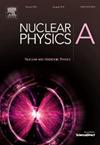Development of the detector array for photons, protons, and exotic residues
IF 1.7
4区 物理与天体物理
Q2 PHYSICS, NUCLEAR
引用次数: 0
Abstract
Accurate neutron capture predictions are needed in fundamental and applied science. Empirical models are constrained largely for stable nuclei, but predictions far from stability are needed. Neutron transfer in (d, p) reactions in inverse kinematics with rare isotope beams offers a means to access key aspects of the capture process. To this end, the detector array for photons, protons, and exotic residues (DAPPER) has been designed, built, tested, and used for measurement at Texas A&M University.
光子、质子和外来残基探测器阵列的研制
在基础科学和应用科学中都需要精确的中子俘获预测。经验模型在很大程度上受限于稳定的原子核,但离稳定还很远的预测是需要的。(d, p)反应中的中子转移与稀有同位素光束的逆运动学提供了一种获取捕获过程关键方面的手段。为此,在德克萨斯农工大学设计、建造、测试并用于测量光子、质子和外来残留物的探测器阵列(DAPPER)。
本文章由计算机程序翻译,如有差异,请以英文原文为准。
求助全文
约1分钟内获得全文
求助全文
来源期刊

Nuclear Physics A
物理-物理:核物理
CiteScore
3.60
自引率
7.10%
发文量
113
审稿时长
61 days
期刊介绍:
Nuclear Physics A focuses on the domain of nuclear and hadronic physics and includes the following subsections: Nuclear Structure and Dynamics; Intermediate and High Energy Heavy Ion Physics; Hadronic Physics; Electromagnetic and Weak Interactions; Nuclear Astrophysics. The emphasis is on original research papers. A number of carefully selected and reviewed conference proceedings are published as an integral part of the journal.
 求助内容:
求助内容: 应助结果提醒方式:
应助结果提醒方式:


